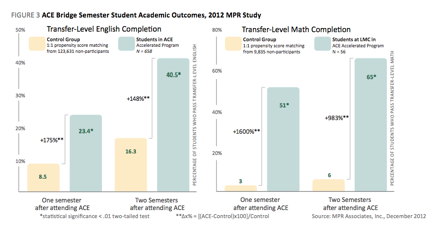Focus on Team Development, Learning
Challenge
In 2002, 5 Dynamics founder Michael Sturm worked with a high-tech company executive to develop a programmatic model to assist underprepared (“at-risk” and “high risk”) youth to achieve their educational goals; the original target student population was underprepared Latino students in a rural, agricultural community. The initial pilot program was funded by a National Science Foundation grant.
This collaboration eventually became the Academy for College Excellence (ACE). The mission of ACE is threefold:
- To give underprepared community college students the opportunity to better their lives by helping them develop the academic qualifications, professional skills, and personal attributes necessary to succeed.
- To “bridge” students into regular community college courses via one full-time, semester-long transformative learning environment focused on academics and self-efficacy.
- To increase the number of students who emerge from community college prepared for a knowledge-work professional career with a future.
Action
All students complete the 5 Dynamics Assessment and enter the ACE’s Foundation of Leadership course—an intensive, two-week course which “primarily focuses on promoting students’ personal development, lighting or igniting a passion for learning and introduces them to communications and work styles critical for team collaboration.” Students devote the first week to concentrated, hands-on exercises designed to teach about Energies, learning styles, the Project Completion Cycle, and applying 5 Dynamics in peer teams.
Additionally, once they understand their individual learning styles, students are taught how to apply the 5 Dynamics methodology in a variety of ways to maximize their learning and success during their college career—for example, how to leverage their individual learning styles to choose the best instructors for them, get the most out of lectures, and choose study partners who will complement learning.
Within two weeks the cohort emerges from the Foundation course to enter a single “Bridge Semester” to prepare them for a normal curriculum. Within four months they are in accelerated English, math, computer science, career planning, and college-level statistics. This type of progress is unheard-of with underprepared students.
Results
Preliminary results were so strong that the Bill and Melinda Gates Foundation awarded multiple grants to both scale the program nationally and to evaluate its effectiveness at four colleges across the country. The program has also attracted grants from the David and Lucille Packard Foundation, the James Irvine Foundation, the Walter S. Johnson Foundation, the Joyce Foundation, and the Carnegie Corporation of New York.
By 2010, the program had spread to seven partner colleges across the country, and as of 2016 it has now served over 5,000 students and trained over 1,500 faculty from over 60 institutions of higher education to use affective learning methods in their classrooms.

Students in the program are 66% more likely to enroll in college full-time in comparison to control groups of adequately prepared students. They showed significant gains in self-efficacy, teamwork, and college identity compared to control groups. In a survey of 926 participants, half said they planned to complete an associate’s degree while one third stated they intended to achieve a baccalaureate degree, and 80% said the program had made them more likely to graduate. *
ACE can be found at http://academyforcollegeexcellence.org.
* Karandjeff, K.; Cooper, D. “A student support (re)defined case study: the Academy for College Excellence integrating student transformation, support, and accelerated learning in the classroom,” The Research and Planning Group for California Community Colleges, (2013).